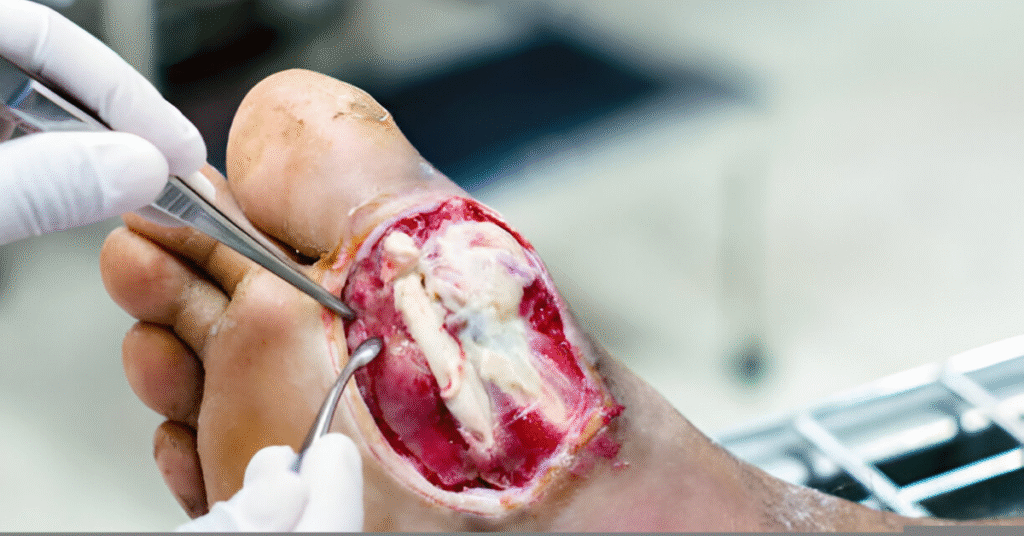Introduction
Living with diabetes comes with a long list of health considerations—but one of the most serious and often overlooked complications is the development of diabetic foot ulcer. These open sores or wounds on the foot can lead to infections, hospitalizations, and in severe cases, amputation if not properly treated.
At Sole Foot and Ankle, we’re committed to helping patients in Valparaiso, Indiana, understand the “why” behind foot ulcers, so you can stay one step ahead with prevention and care. In this post, we’ll walk you through what diabetic foot ulcers are, why they occur, and what you can do to protect your feet.
What Is a Diabetic Foot Ulcer?
A diabetic foot ulcer is an open sore or wound that usually forms on the bottom of the foot. These ulcers occur in roughly 15% of people with diabetes and can quickly become serious without prompt treatment.
These wounds often start small but can worsen due to poor circulation and reduced feeling in the feet—a common effect of diabetes.
Why Do They Happen?
Root Causes Explained Simply
Several factors contribute to why diabetic foot ulcers occur, including:
1. Poor Circulation (Peripheral Arterial Disease)
Diabetes can cause your blood vessels to narrow and harden, reducing blood flow to the feet. This slows the healing process and increases your risk of infection.
2. Nerve Damage (Peripheral Neuropathy)
High blood sugar over time can damage nerves in the feet, leading to numbness or tingling. Without feeling, you might not notice cuts, blisters, or pressure spots—allowing minor injuries to develop into ulcers.
3. Foot Deformities
Conditions like bunions, hammertoes, or flat feet can create uneven pressure on the feet. These pressure points are common areas where ulcers form, especially in people who walk often or wear ill-fitting shoes.
4. Infection
Once the skin barrier is broken, bacteria can enter the wound. Diabetes weakens the immune system, making it harder to fight off infection.
5. High Blood Sugar
Uncontrolled diabetes affects nearly every aspect of healing. High blood sugar slows tissue repair and increases the likelihood of infection.
Who’s Most at Risk?
You’re more likely to develop a diabetic foot ulcer if:
- You’ve had diabetes for many years
- You have poor blood sugar control
- You smoke
- You’ve had a previous foot ulcer or amputation
- You have foot deformities or calluses
- You don’t regularly see a foot doctor or podiatrist
If any of these apply to you, it’s time to get proactive about foot care.
Early Warning Signs to Watch For
Catching a problem early can make all the difference. Look out for:
- Redness or swelling
- Areas of the foot that feel unusually warm
- Skin discoloration or dark spots
- Drainage or pus in your socks
- Foul odor
- Thick calluses or cracks on the bottom of your foot
- Pain or numbness
If you notice any of these signs, don’t wait—see a podiatrist in Valparaiso right away.

How to Prevent Them
Preventing foot ulcers starts with daily care and routine check-ups. Here are key steps to protect your feet:
- Inspect your feet daily for blisters, cuts, redness, or swelling.
- Keep your blood sugar controlled to support better healing.
- Moisturize your feet to prevent cracking but avoid between the toes.
- Trim your nails carefully—or have a podiatrist do it.
- Avoid walking barefoot, even indoors.
- Wear diabetic-friendly shoes and socks that reduce pressure points.
- Visit your podiatrist regularly for checkups and custom care.
Treatment Options: What to Expect
If you do develop a diabetic foot ulcer, early treatment from a podiatrist is essential. At Sole Foot and Ankle, your care may include:
- Wound cleaning and debridement
- Pressure relief with special shoes, orthotics, or casts
- Antibiotics if infection is present
- Blood sugar management in collaboration with your physician
- Surgical care for advanced or non-healing wounds
Healing time varies, but most ulcers can improve significantly with early intervention.
When to See a Podiatrist
Don’t wait until an ulcer becomes serious. You should schedule a visit to a foot doctor if:
- You have diabetes and foot pain, numbness, or visible changes
- You’ve noticed a new sore, blister, or wound
- You’re unsure if your shoes are safe for diabetic feet
- You want to create a personalized foot care plan
A Note from Sole Foot and Ankle
At Sole Foot and Ankle in Valparaiso, Indiana, we specialize in diabetic foot care that keeps you active, healthy, and ulcer-free. Whether you need preventive support or wound treatment, we’re here with expert care, personalized plans, and compassionate service.
Protect your feet—protect your future.
Schedule an appointment today or call us to learn more about diabetic foot ulcer care.



